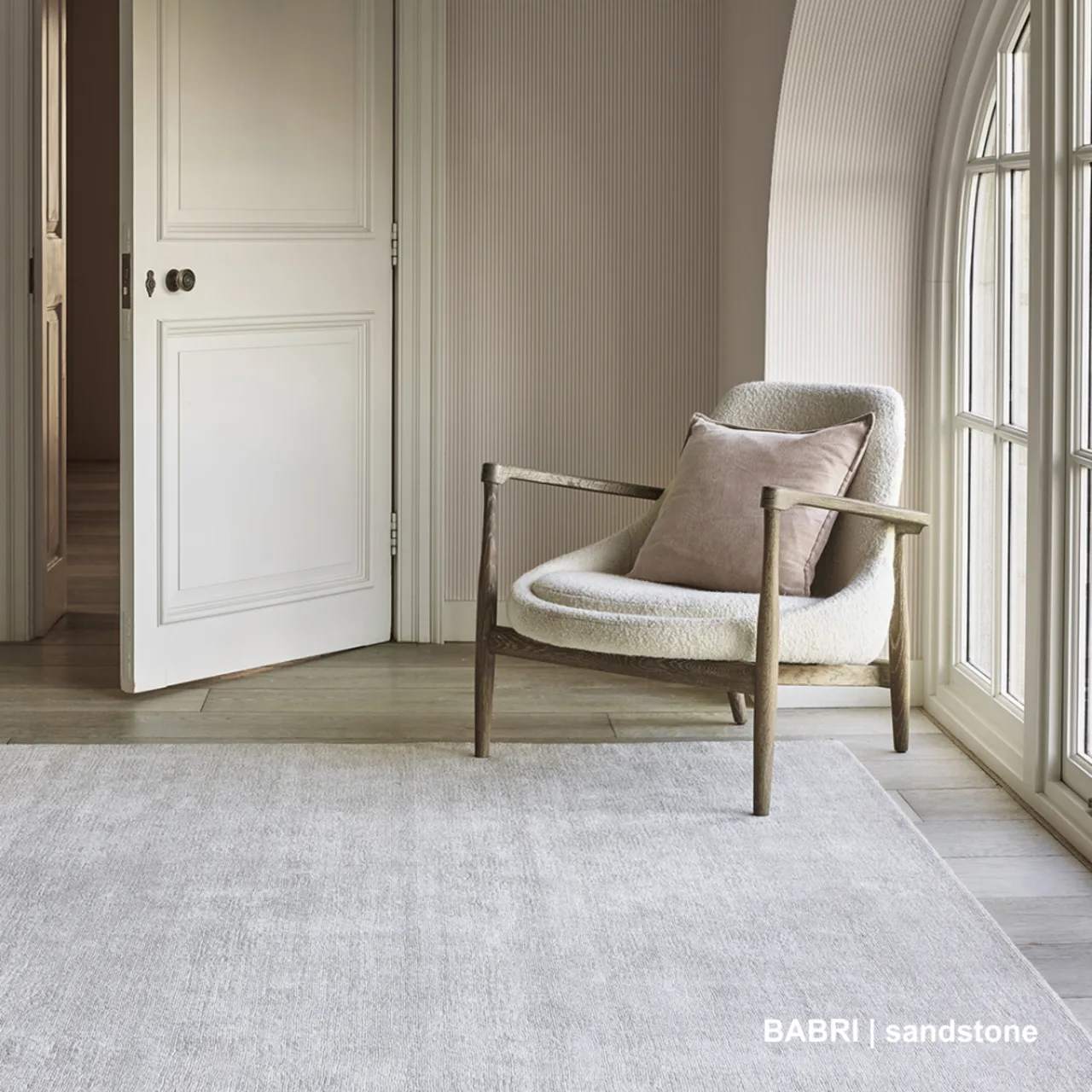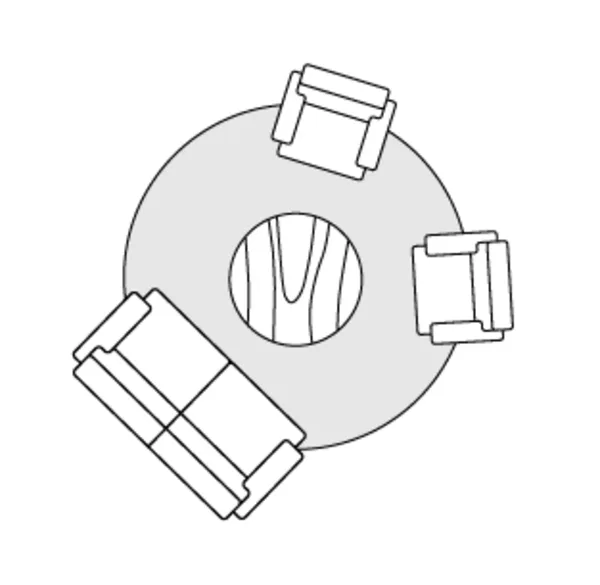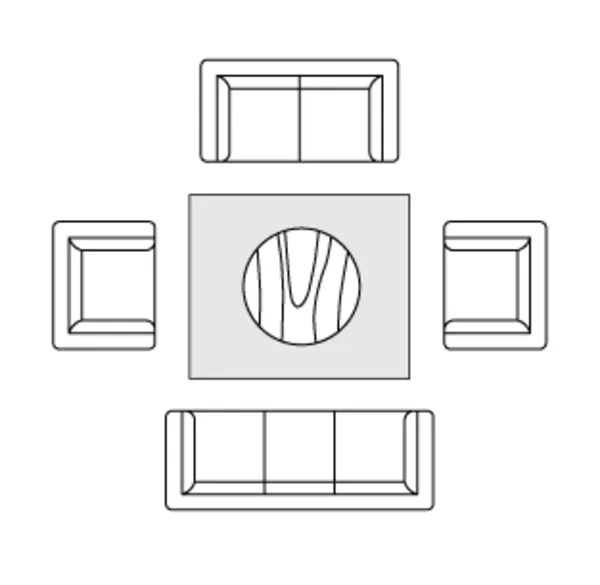Rug Size Guide
Don’t settle for a standard-size rug if you can get the perfect, custom-size rug instead. Many of our customers learn this lesson the hard way when they discover that their standard-sized rug is either too small or too large for their space.
In this guide, we walk you through different layouts for each room in the house and break down the most common sizing mistakes so you can avoid them.

TABLE OF CONTENTS
Specifying a rug for a commercial or hospitality space? Rugs in contract-grade settings must meet strict safety and design standards. For guidance on how to decide the best rug sizes and layouts, check out our Commercial Rug Size Guide and Hospitality Rug Size Guide.
Recommended Rug Size Ranges for Every Room Table
Instead of sticking to standard rug sizes, we believe your space deserves a rug that fits just right. Here’s a guide to help you decide how large or small your rug should be.
Room Type | Recommended Rug Size Range | Design Tip |
|---|---|---|
Living Room | 6' x 9' → 10' x 14' | Keep at least the front legs of the furniture on the rug for a finished look and to anchor the space. |
Dining Room | Table size + ~32" on each side | Ensures chairs slide in and out without catching on the edges of the rug. |
Bedroom (Queen Bed) | 6' x 9' → 8' x 10' | Position the rug under the bottom two-thirds of the bed for a balanced look. |
Bedroom (King Bed) | 8' x 10' → 9' x 12' | Extend the rug beyond both nightstands for a luxurious frame around the bed. |
Entryway | 3' x 5' → 4' x 6' | Center the rug and leave 4–8 inches of visible floor around the edges. |
General guidelines for matching room size to rug size: For a small 10'x12' room, look for a rug in the 5'x8' to 6'x9' range. For a medium 12'x15' room, try an 8'x10' to 9'x12' rug. And large rooms (15'x20' +), start with a 9'x12' and go bigger if needed.
Keep in mind: Every room is unique, and a rug should fit the needs and style of the space. If you need help visualizing your perfect rug size or finding the right material, we’d love to help you plan your space.
What material is best for a rug?
For a deep dive into selecting the best material for your rug, head over to the The Ultimate Guide to Rug Fibers: Everything You Need to Know blog post.
%2Ff_auto%2Fq_auto%2Fw_1280%2Fv1710355353%2FFlooring%2FOther%20Assets%2FIn%20House%2FLayered-rugs-3-CG_fj62zf.webp&w=2560&q=75)

Most Popular / Budget Friendly
The most preferred and cost-saving staging option places the two front legs of your sofa and chairs on top of the rug to frame an inviting seating area. This works well for medium and smaller sized rooms.

Open Concept or Large Rooms
If you have a big living room or an open concept space, consider arranging all furniture—your sofa, chairs, coffee and side tables—on top of the rug. This creates a cohesive look that defines the space and makes it feel intentional and well-balanced. Opt for the largest rug size you can afford.

Rule of Thumb
Give the rug at least another foot on either side of the longest piece of furniture. If you have side tables, factor their width into the calculations. You don't want half of the legs on the rug and the other half off the rug.

Round or Organic Shaped Rugs for Lobbies
Try a uniquely shaped rug like a round or organic-shaped rug design to soften lines and add visual intrigue to living rooms or sitting areas. Follow the link below to learn more about irregular or organic shaped rugs.

What is the "dreaded rug island"?
It’s a term used by designers for a small area rug placed in the center without any seating on it. It makes the furniture look like it is floating in space and does not convey the cohesion a living room or gathering space deserves (especially in open floor plans). Not recommended!

How much space should there be between the edge of a rug and the wall?
If you want to avoid the "wall-to-wall carpet look," leave 12-18 inches of bare floor all the way around your area rug and the wall for large rooms and 6-8 inches for smaller spaces. This border frames the room and keeps the rug from overwhelming the space.

Large Bedrooms & Hotel Rooms
If the primary bedroom is sizable, we recommend that all furniture is placed on a large area rug—queen or king size bed plus two nightstands.

Smaller Rugs in Bedrooms
If the room is smaller or the rug is not large enough to hold all furniture pieces, tuck the rug under the bed just up to the nightstands.

How wide should a bedroom rug be?
You either want the width of the rug to include the nightstands or extend at least beyond 18 inches on either side of the bed. This way, your feet have a soft landing whenever you step out of bed.

Bedside Runners
Yes, you can put runners on both sides of the bed. This is an economical but no less cozy approach to creating a finished look in a bedroom. Follow the link below to create custom sized runners.

Can I put an area rug on top of wall-to-wall carpet?
Wall-to-wall carpeting adds extra padding and absorbs sound, a perfect addition to bedrooms. If the room already has wall-to-wall carpeting, you can always add an area rug as a design element or focal point, either perpendicular to the bed or as a runner alongside the end.

Standard-Sized Rugs Don't Fit
The biggest mistake customers make is buying a standard-sized rug that doesn't fit the table with the chairs pushed out. There is nothing worse than sliding your chair in or out and getting stuck on the edge of a rug.

How much larger should a rug be than the table?
Add about 32 to 36 inches to each side of the table’s dimensions to comfortably move chairs in and out. Whether the table is rectangular, round, or oval, a custom-size rug with the right chair clearance creates a relaxed dining experience.

Oval Rugs
Oval rugs are a beautiful choice for dining rooms, especially under oval or rectangular tables where they add to the fluid look or soften harsh lines. Follow the link below to learn more about custom cut rugs and how to create an oval shaped rug.
What size rug should I get if I have an extendable table?
It all depends on how often you use your table’s extensions. If you only entertain large groups two to three times a year, then stick with a rug that fits your unextended table. If in doubt, get a rug that accommodates the table with or without extensions.

What size rug works best in a galley or open-concept kitchen?
For galley kitchens, L-shaped kitchens, or kitchens with an island, place a decent-sized runner along the longest side of your cabinets. This way, you cushion most of your steps and protect your tiles or hardwood floors from being banged up by the occasional knife drop.

Rugs for Small Kitchens
For a smaller kitchen, place a petite area rug where you spend the most time to protect the floors, cushion your feet and add a design element. Polypropylene rugs are a budget-friendly, easy to clean option for small spaces.

How wide should a kitchen runner be?
Leave at least 3 to 6 inches on each side in small areas and up to 24” in large kitchens for your tile or hardwood floor to remain visible. To help you determine how many inches to leave exposed, think about where you spend the most time standing—do you want your feet to straddle the edge of a rug or be fully on top of the rug?
I need a custom cut rug that wraps around my kitchen island.
No problem. We custom create L-shaped rugs or other irregular shaped rugs to fit your exact specifications. Head over to Irregular Shaped & Custom Cut Rugs to learn more.

Rugs for Small Bathrooms
Match your bathroom rug to the length of your single or double vanity. This approach is budget-friendly but still dresses up the space and provides a warm foundation. Don't forget a rug pad to prevent slipping!

Large Bathrooms
A larger space allows for more flexibility. You can place two area rugs in front of your vanity or just one large bathroom rug. The rug shape is also up to you and the room's layout—from square to rectangular or oval to circular—a custom-sized rug is the perfect complement.

How much exposed bathroom flooring should I see?
Large or small, when sizing your new bathroom rug, leave at least 3 to 6 inches of visible tile or hardwood flooring (especially if the flooring is beautiful!). This creates a tailored border for a finished look.

A Large Entryway Needs a Large Rug
Larger is always better. Entryway rugs help trap dirt, moisture, and mud, and the longer the rug, the less chance debris will track onto floors or other rugs. Your rug or runner should be centered in front of the entrance.

Add a Walk-Off Mat
No matter the size of your entryway, add a tough walk-off mat outside of your front door. This is an efficient way to trap gravel, sand, and mud before it enters your house.

Door Clearance & Entryway Rugs
Always measure door clearance and determine the pile height of your rug so the door can open freely over the rug. If opening the front door does not allow for a rug, center a rug in the space or lay it in front of a foyer bench or table.
How much space should I leave between the rug and the wall or furniture?
Leave 3 to 6 inches on each side of the rug to create a frame. This helps makes the space feel balanced and polished. However, make sure that the height of the rug doesn't interfere with the opening and closing of the door.
Browse our Outdoor | Anywhere Collection and if you have additional questions or can’t wrap your mind around your specific space needs, please chat with our team of experts.






